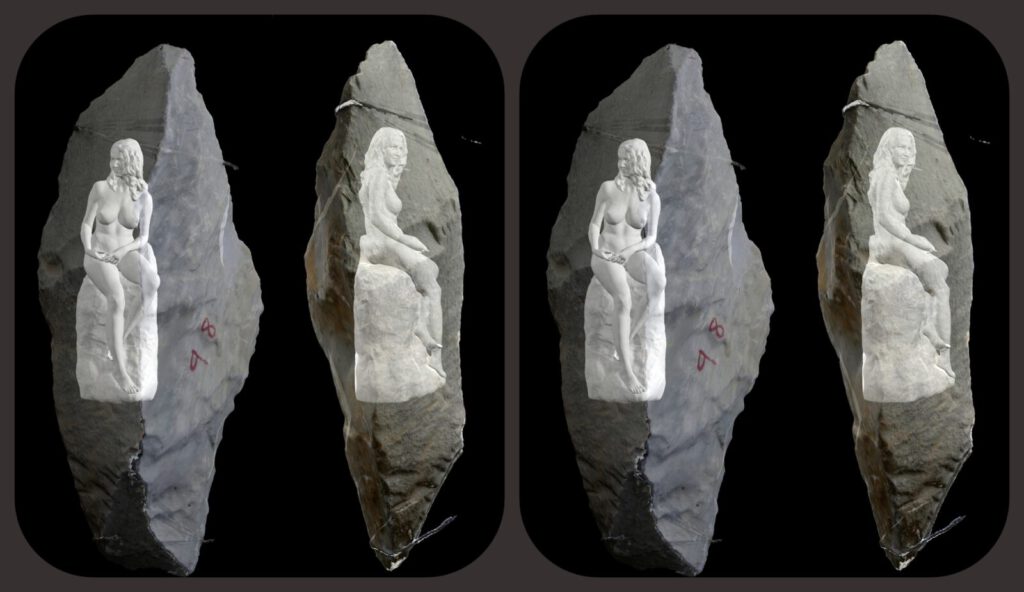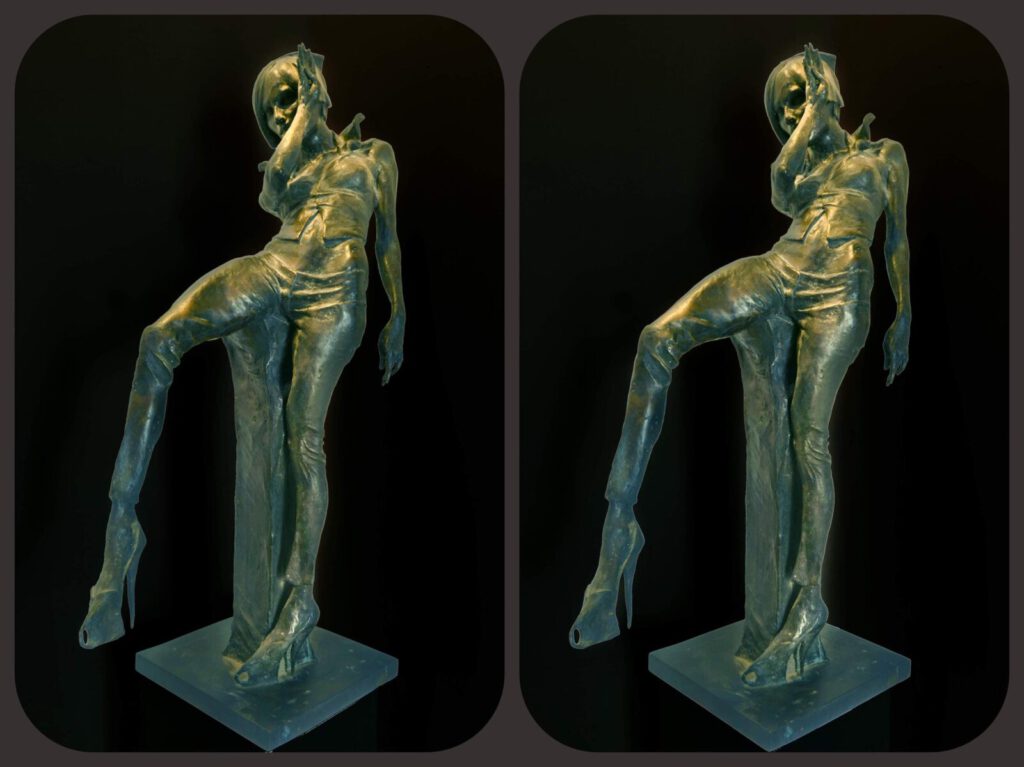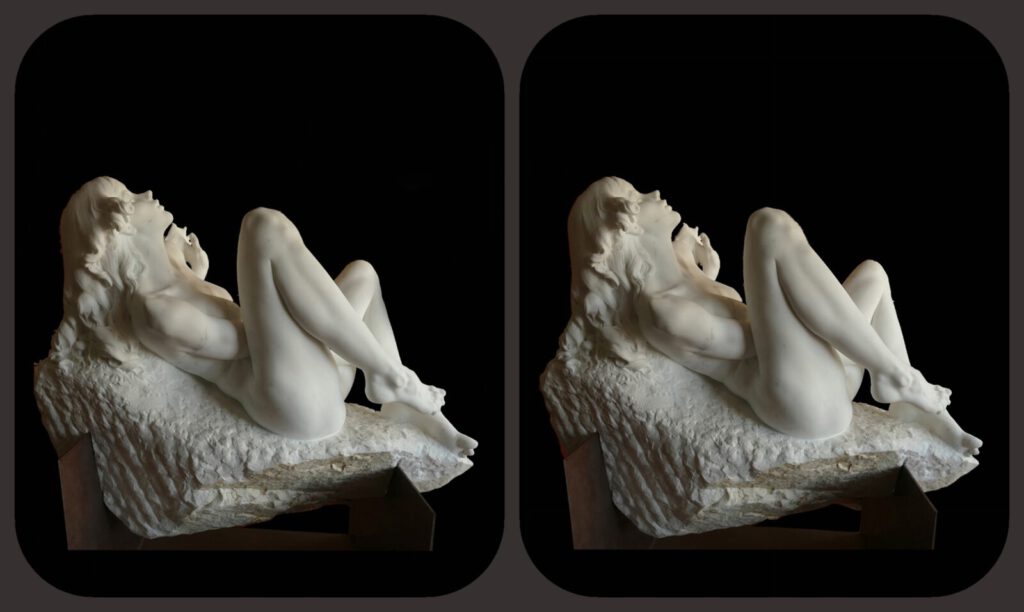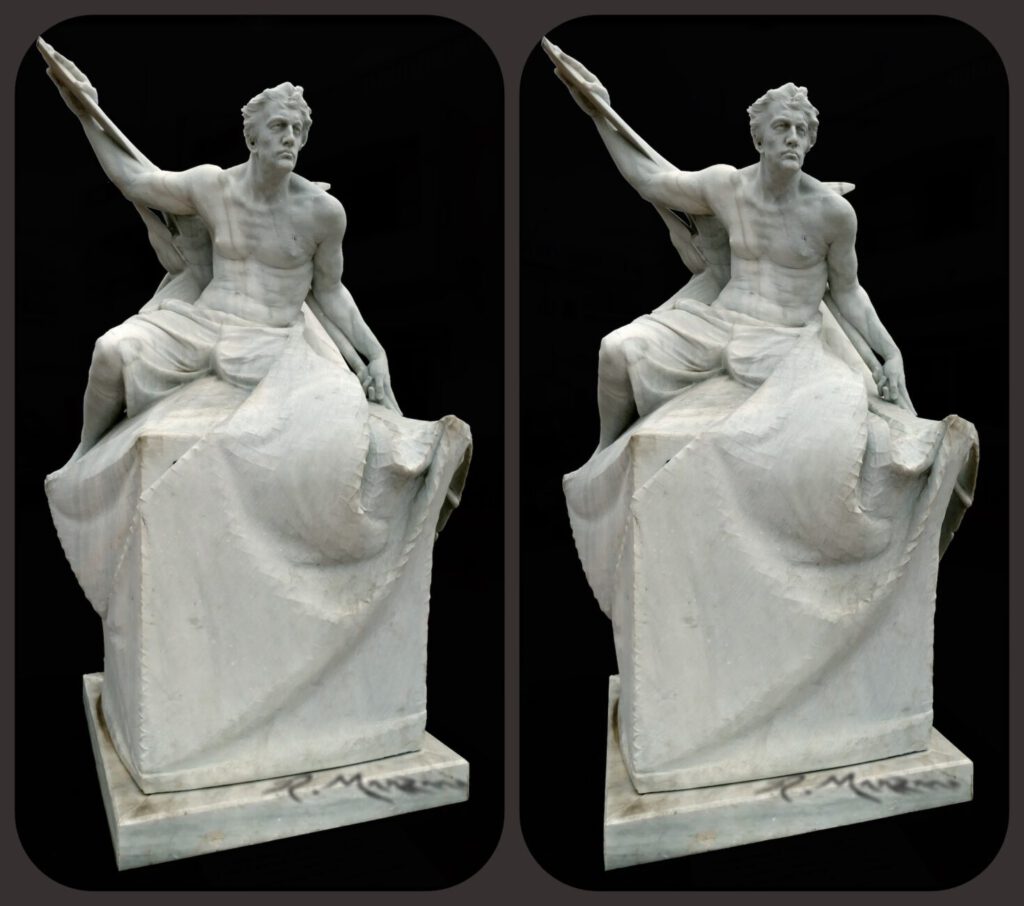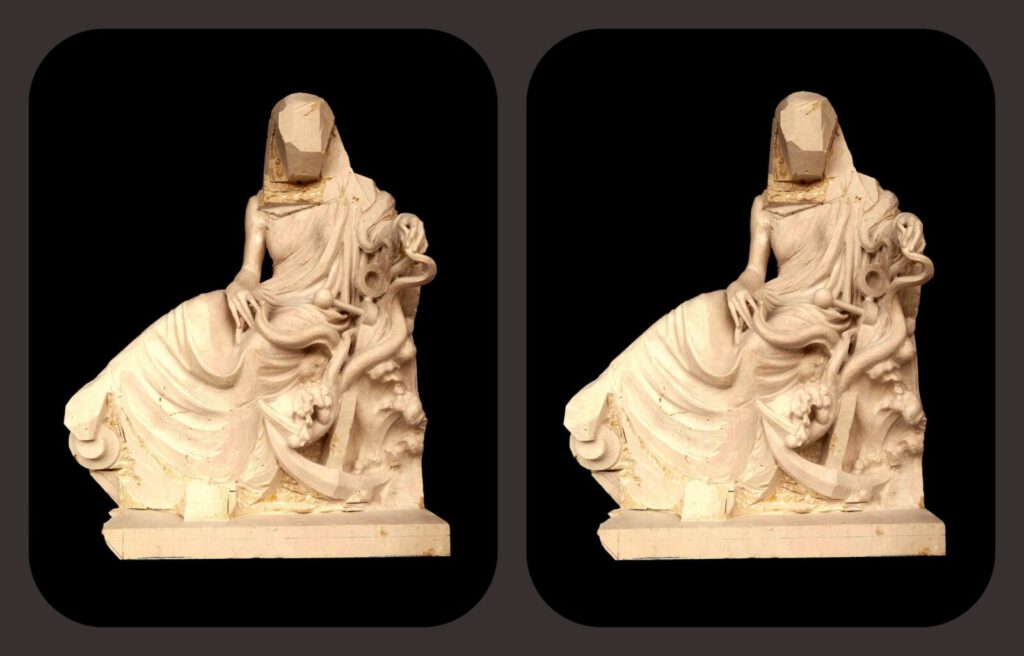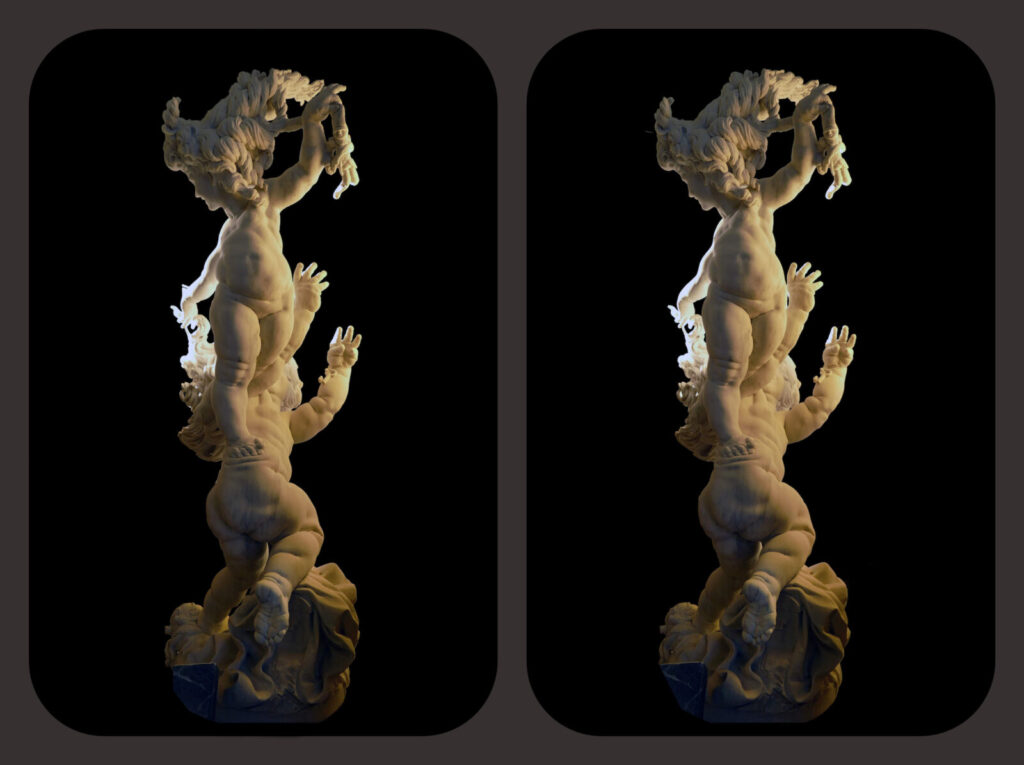Symbiosis of art — a sculptor’s stereo photos
written for the stereosite by Roberto Manzano, Spain
The reason for this article is to attempt to explain the relationship between my profession as a sculptor and the stereoscopic image.
Unlike painting, in sculpture, the perception of spatial depth may be the most important thing to consider. The relationship of each of the elements distributed in the space is the real challenge to take into account in creating sculpture. In the vast majority of cases, color is dispensed with to focus attention on three-dimensional shapes. In a traditional two-dimensional photograph of a sculpture that perception of depth is lost, and therefore two-dimensional photography is a very ineffective means to represent the spatial awareness of a sculpture.
When one day I had the opportunity to learn about the stereoscopic representation of an image, I understood the true meaning of photography and the magic it can bring to any type of image. Since then, etheric photography has been an important tool, if not the most important, to capture, copy and represent everything I see and believe, not only in the world of sculpture, but in all aspects of life. I also want to relate my photographs to the stereoscopic daguerreotypes of the mid-nineteenth century as a tribute and reminder of a technique that despite being more than 150 years old, is unequivocally more modern in concept than the standards we use today.
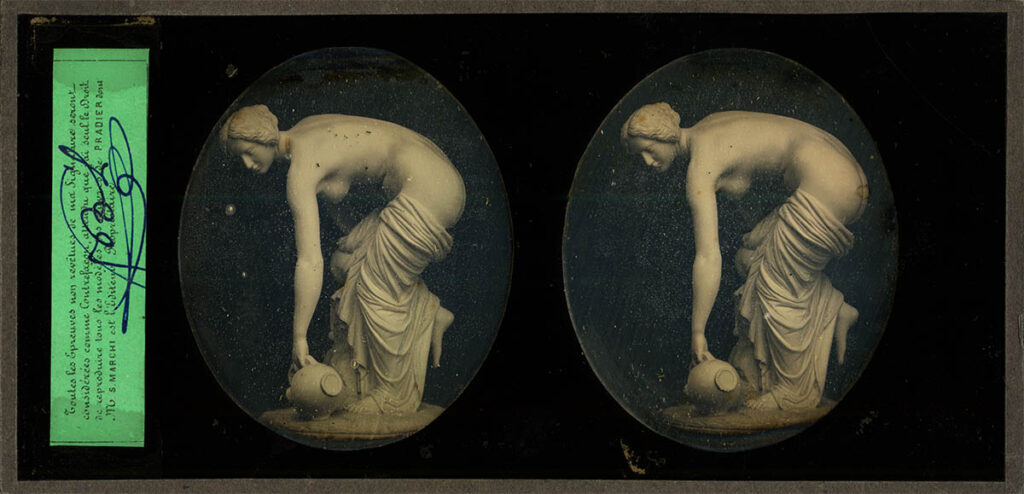
Female sitting nude
This slightly larger than life size sculpture represents a portrait of a woman. A tribute to a person who loves himself. The pose is idealized, while the face responds to reality. In this piece, the position does not portray very exhibitionist spirit, but is rather relaxed and natural, without looking for anything expressive beyond the simple fact of being aware of being naked. The position of the hands and the treatment of the hair is what I have enjoyed the most about the sculpture.
I am still working on finishing this sculpture in my workshop.
In some images I want to show visually where the sculpture is located inside the marble block before starting to carve it. To do this, I have utilized one of the possibilities that photography offers, which is photogrammetry. It is nothing more than the ability of stereoscopy to understand depth, guided by a computer program. This allows me to get a polygonal model of the marble block fresh from the quarry. Once digitized, I manipulate it in a three-dimensional environment, taking into account the scale, using the computer. Here I can combine it with the digitized model of the sculpture, to place the completed sculpture exactly where it suits me best within the block of marble. It is interesting to view the possible results in stereoscopic images, playing with transparencies and other elements to understand the three-dimensional environment in which the sculpture is located within the block of marble.
Extremófilo (Extremophile)
Extemófilo is a 60 cm tall bronze sculpture. It is found in a private collection.
It represents a girl in an unnatural, purely exhibitionist position, intended only to attract attention. The accessories are also absurd, only justified by the clear intention of enhancing the figure of the body on display.
The purpose is not to criticize the absurdity of the girl’s intention with her posture, but rather, to show one more facet of the human being that causes me to pigeonhole her as a being with extremophilic capacities.
Equilibrio
White Carrara marble sculpture of a young woman lying on her back. It is represented in life size.
It began as a commission to make a stand for a table. The only condition was that the main motive had to be a female figure. The first sketches resulted in this position and it was ruled out that it should serve as a support for a table. The posture made sense on its own.
Balance represents an ideal state between the mind and the body, a kind of natural connection that thoughts transfer to the body; and the mind, in turn, receives the result of the stimuli from the body.
In this piece, I felt very comfortable with the type of marble, since it offered me the possibility of representing the anatomical details that I considered very necessary to give realism to the human figure. I also wanted the material from which it is made to be evident and also to show contrast between the soft leather and the raw stone.
Monument to the Fisherman
The Monument to the Fisherman is a 250cm high marble sculpture. It is located in Carboneras, a town on the coast of Almería in Spain. It represents a fisherman who has just caught a swordfish. He is leaning on a fishing net and gazing out at the sea, aware that the battle he has just fought has ended in the same difficult scenario which he faces each day.
Swordfish is one of the typical products of the fishing of this town.
Goddess of Fishing
This sculpture is part of the sculptural group that forms the cover of the hotel “Maravilla Palace” in Estepona (Malaga).
The group is made up of two goddesses, fishing and agriculture, and a central shield with the hotel’s logo. The figures are life-sized, sculpted in cream-colored limestone, which is the same stone used in the building itself.
I am currently working in the final phase of competing these sculptures.
I thought it would be interesting to show photos of the work in process, since it is the least known aspect of stone sculptures.
The Goddess of Fishing has as representative attributes, an anchor, a headdress with typical sailors braids and a squid that seems to attend to the gestures that she makes with her hands. Her position is very sedentary, looking down to greet people as they approach the front door of the hotel.
The Game
This sculpture is two meters high. It is carved from a single block of marble. The scene represents a girl and a boy playing. The intention is to represent a power competition, in which each player uses different strategies to achieve their goal.
The child below, plays with a doll that is a soldier, representing the power of force, and a chest that represents the power of money. He protects it under his knee. The girl is given a doll.
The game consists of the girl trying to achieve the power that the boy has. To accomplish this, the girl is snatching one of the keys that the boy has in his possession, taking advantage of the fact that he is distracted trying to recover his doll. The child does not use a thoughtful strategy, he only becomes enraged and tries to achieve his goal by force. The girl is interested in economic power, so she focuses on getting one of the two keys that open the chest that the boy controls. She has reflected on her strategy, feels confident with her plan and is more elegant as she can envision how her plan begins to succeed.
In short, the boy, confident in his strength, believes that he can remain dominant without issue, while the girl has had to draw up a plan, since she could not best the boy using her weapons.
This sculpture was one of the first works that I created when I had the opportunity to buy a block of marble twenty years ago. I still have it in my workshop. For me it was a complicated technical challenge, a test to demonstrate to myself how far I could go when transitioning the model of a sculpture with complex shapes to a block of marble without making irreparable mistakes.
Roberto Manzano (Almería, Spain)
My career began in Madrid, with a high level of technical training applied to sculpture. My first experiences were presented in workshops of stone reproductions and carvings in expanded polystyrene. A public competition offered me the opportunity to create my first work in bronze on Palma Street in Madrid. I moved to Almería In search of marble and there I have developed most of my work. I have made numerous monumental sculptures for various towns in Almería and in other Andalusian provinces. I have also created sculptures for individual architectural projects, and at the same time I have been developing more personal pieces.
My large format work can be found in different countries throughout Europe, Asia and America where I have received several international awards and recognitions. This has given me the opportunity to share experiences with sculptors from all over the world.
Currently, I incorporate many digital tools into the creative and technical process. These include: design and modeling computer programs, numerical control reproduction methods applied to sculpture, as well as photographic techniques to visualize shapes in stereoscopic 3D and digitization of shapes using photogrammetry.
I consider stereoscopy a critical tool in all aspects of sculpture. Since I first encountered it six years ago, my interest in this field has grown so that I consider it nearly my most versatile tool. It allows me to capture and represent the three dimensional reality in which I live. The use of stereoscopy is not just a visualization tool, it also allows me to take molds of the forms represented in stereoscopic images.
Instagram-profile: 3d.manzanorober

